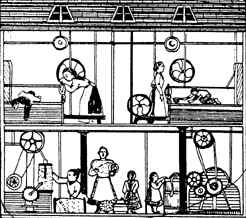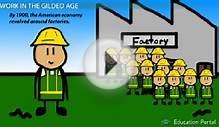
©1996-2016
womeninworldhistory.com
Samuel Courtauld built a silk mill in 1825 in Halstead, Essex (South East England).
Before the Industrial Revolution, Halstead was an agricultural community with a cottage industry producing woolen cloth. In Halstead, as elsewhere in England, unemployment among depressed farming households and former wool workers forced people to find work outside the home. Because their labor was cheap, women more than men were recruited into the textile factories that sprang up all over Britain in the 19th century. This is a chart of the Courtauld workforce in 1860. The wages are in British schillings.
| MALES | ||
| Mill Manager (Also got 3 per cent of the profits) | ||
| Overseers and clerks | ||
| Mechanics and engine drivers | ||
| Carpenters and blacksmiths | ||
| Lodgekeeper | ||
| Power loom machinery attendants and steamers | ||
| Mill machinery attendants and loom cleaners | ||
| Spindle cleaners, bobbin stampers and packers, messengers, sweepers | ||
| Watchmen | ||
| Coachmen, grooms and van driver | ||
| Winders | ||
| Total Males | ||
|
Number |
FEMALES | |
| Gauze examiners | ||
| Female assistant overseers | ||
| Warpers | ||
| Twisters | ||
| Wasters | ||
| Weavers | ||
| Plugwinders | ||
| Drawers and doublers | ||
| Total Females | ||
| GRAND TOTAL WORK FORCE |
QUESTIONS 
Make a list of jobs only men did. A list of the jobs women did. Can you think of any reasons for this? Were women less capable than men of doing this work? (You might have to find out what some jobs were!)
What do you notice about the wages for men's jobs compared with the pay for the women's jobs?
What is the highest paying job? the lowest?
In what job do males and females receive the same pay?
In what job are the majority of men employed?
In what job are the majority of women?
What is the approximate ratio of male workers to female workers?
Think about the pattern of the employment at the factory of a man and of a woman. Who might be able to work their way up the ladder? Who will most likely end up in a "dead end" job? What factors might have contributed to this pattern of lifetime job difference? What implications might this have on the status and power of women within the community? Within the family?
In factories that mainly employ women today, can you find out what percentage of men or women hold the best paying jobs?
[Source: For Courtland silk factory wages: Carol Adams, Paula Bartley, Judy Lown, Cathy Loxton, Under Control: Life in a nineteenth-century Silk Factory, Cambridge University Press.]
2) Evidence of Textile Workers in Wilson's Mill, Nottingham:
Hannah Goode: "I work at Mr. Wilson's mill. I think the youngest child is about 7. I daresay there are 20 under 9 years. It is about half past five by our clock at home when we go in.We come out at seven by the mill. We never stop to take our meals, except at dinner.
William Crookes is overlooker in our room. He is cross-tempered sometimes. He does not beat me; he beats the little children if they do not do their work right.I have sometimes seen the little children drop asleep or so, but not lately. If they are catched asleep they get the strap. They are always very tired at night.I can read a little; I can't write. I used to go to school before I went to the mill; I have since I am sixteen."
Mrs. Smith: "I have three children working in Wilson's mill; one 11, one 13, and the other 14. They work regular hours there. We don't complain. If they go to drop the hours, I don't know what poor people will do. We have hard work to live as it is. My husband is of the same mind about it...last summer my husband was 6 weeks ill; we pledged almost all our things to live; the things are not all out of pawn yet. We complain of nothing but short wages...My children have been in the mill three years. I have no complaint to make of their being beaten...I would rather they were beaten than fined."
[Source; Factory Inquiry Commission, Great Britain, Parliamentary Papers, 1833. Found in Hellerstein, Hume & Offen, Victorian Women: A Documentary Accounts of Women's Lives in Nineteenth-Century England, France and the United States, Stanford University Press]
What do you think happened to younger children when the family was away at work in mills?
What might be different about work done at home compared to work in the factory?
Why did some workers oppose the imposition of laws restricting women and children's work?
RELATED VIDEO




 Manchester /ˈmæntʃɛstər/ is a city and metropolitan borough in Greater Manchester, England with an estimated population of 498,800 in 2010. Manchester lies within one of the United Kingdom's largest urban areas; the Greater Manchester Urban Area which has a...
Manchester /ˈmæntʃɛstər/ is a city and metropolitan borough in Greater Manchester, England with an estimated population of 498,800 in 2010. Manchester lies within one of the United Kingdom's largest urban areas; the Greater Manchester Urban Area which has a...
 Samuel Cunliffe Lister, 1st Baron Masham, (1 January 1815 in Calverley Old Hall, Yorkshire – 2 February 1906 in Swinton Park, Yorkshire) was an English inventor and industrialist, notable for inventing the Lister nip comb.
Samuel Cunliffe Lister, 1st Baron Masham, (1 January 1815 in Calverley Old Hall, Yorkshire – 2 February 1906 in Swinton Park, Yorkshire) was an English inventor and industrialist, notable for inventing the Lister nip comb.







